Salamanders and Mountains
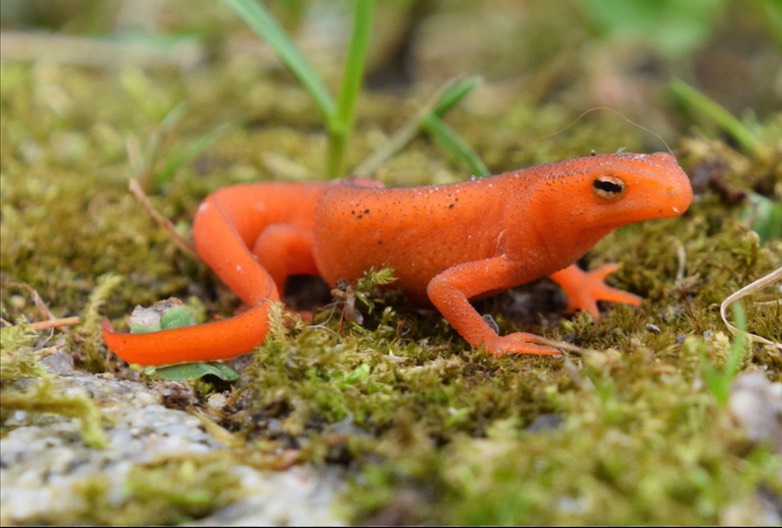
By Linda Martinson
During these days of pandemic, there is time to contemplate our mountain views. The view is always changing, but the mountains seem timeless and they almost are.
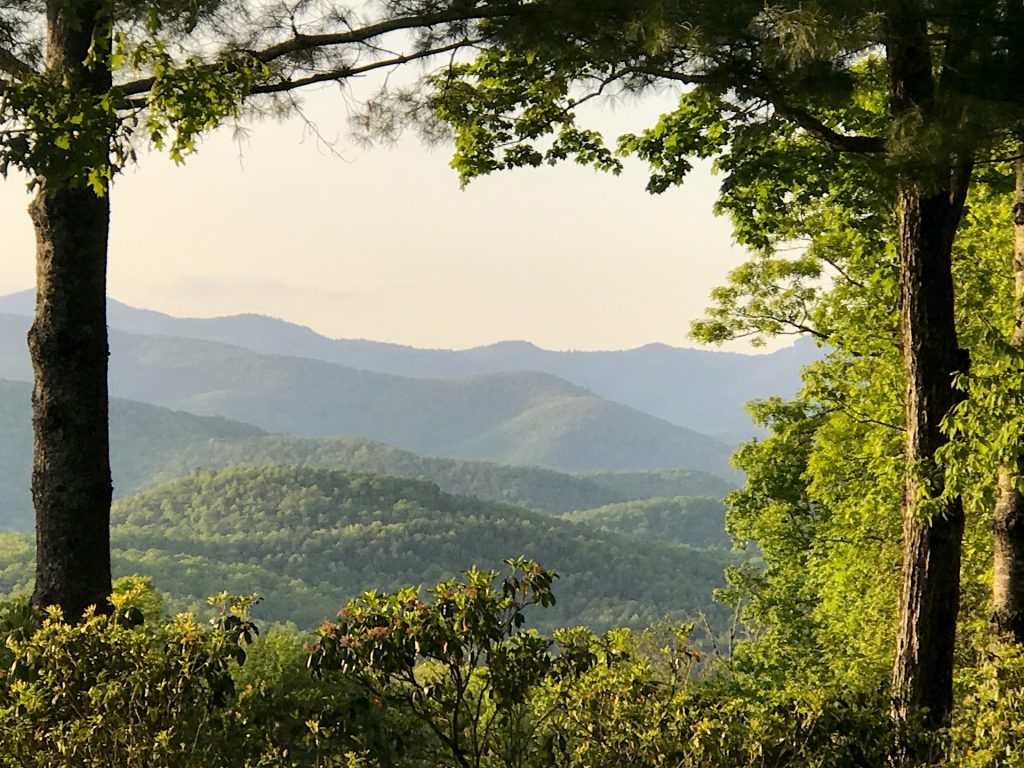
The Blue Ridge Mountains in the Appalachians are 1.2 billion years old and among the oldest mountain ranges in the world. The highest peak is Mount Mitchell at 6,684 feet, and the range has an average elevation of 2,000 – 4,000 feet. The Appalachian Mountains have been uplifted and eroded during at least four different periods over millions of years, and these cycles of mountain formation and erosion have resulted in an ancient and persistent mountain range with amazing biodiversity.
The major event that shaped today’s Appalachian mountains occurred around 330+ million years ago when the continent of Africa smashed into North America forming the super-continent of Pangea, centered on the equator and surrounded by the super-ocean Panthalassa. That mighty collision created mountains estimated to have been as high as 26,000 feet, comparable to the highest mountains in the world today. Since then, the Appalachian mountains have been eroding to their current height and range. And at about the same time the present Appalachian mountains began eroding, salamanders left the ocean and became the first species of land dwelling animals.
And so, the Appalachians we live in now were young about 330+ million years ago and the dominant land animals then were salamanders. When salamanders evolved from the ocean onto land, there were no other mammals, birds or reptiles and there were no flowering plants e.g., no maple or oak trees, orchids, or trilliums. There were, however, forests of giant ferns, clubmoss and horsetail that still appear in our forests today as small plants, and early seed plants had just begun to evolve
Salamanders descended from ancient ocean fish, their totally aquatic vertebrate ancestors of roughly 397 million years ago. Their evolution from an aquatic animal to the first terrestrial amphibian occurred gradually over 65+ million years culminating in the beginning of animal life on our planet about 330+ million years ago. Salamanders were the first tetrapods, members of the super-class tetrapoda. Tetrapods include all vertebrate animals higher than fishes, extant and extinct: i.e., not only amphibians; but also mammals (including humans); all birds; and reptiles including snakes, lizards, turtles, tortoises, crocodiles, and alligators. Note: reptiles evolved from ancient fish in a separate evolutionary direction from amphibians even though they have some similar features. (britannica.com)
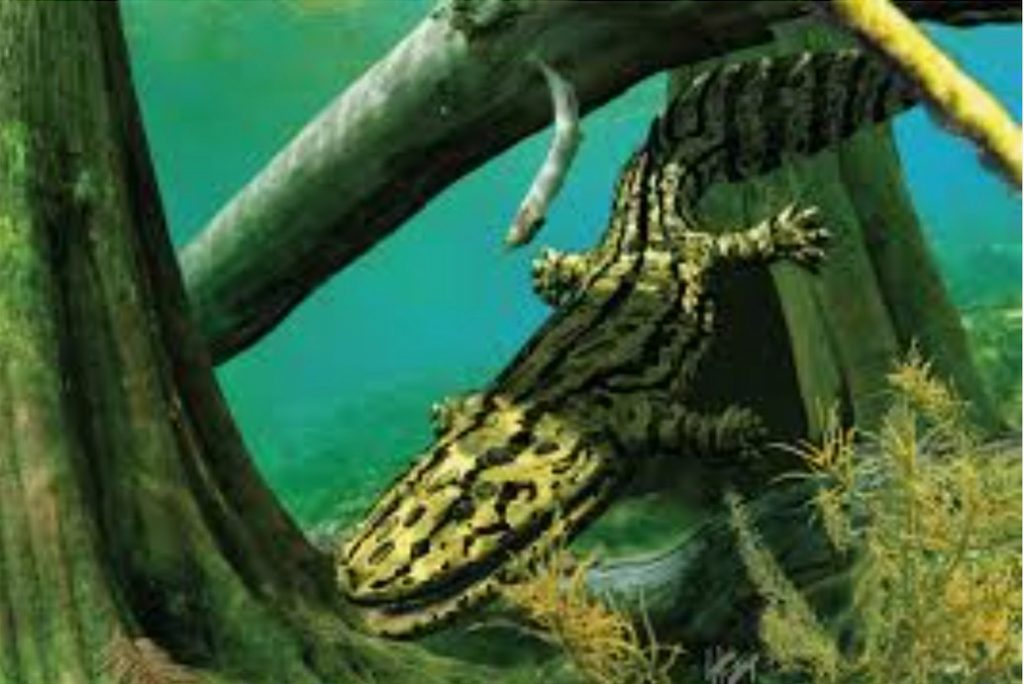
sciencemagazine.org
After salamanders evolved to live on land, tetrapods eventually divided into two main classes: amphibians (generally all tetrapods with a larval stage, usually in water) and amniotes. Amniotes also are divided into the two classes: synapsids, that later evolved into mammals, and sauropsids that include reptiles and birds and their fossil relatives.
Extant amphibians include salamanders, newts, frogs, toads, and caecilians or blindworms. They are small cold-blooded vertebrates i.e., they have backbones and depend upon the environment to regulate their body temperature. The name amphibian is derived from the Greek word amphibios, “living a double life,” and it is an apt class name because amphibians exploit both aquatic and terrestrial habitats. Some amphibian species are permanent land dwellers while other species have a completely aquatic mode of existence, but all amphibians at some stage of their development require water or a moist environment to survive and they can absorb water through their thin skins. Including salamanders, there are now roughly 8,100 living species of amphibians and because they have been around for so much longer, salamanders have had more evolutionary experiments in habitat and reproductive mode than any other amphibian or vertebrate group and they have a relatively complex behavioral repertoire.
For example, salamander tails are used for courtship, defense, and as a storage unit for proteins and lipids. And conveniently, salamanders can regrow entire limbs including their tails and even regenerate parts of major organs apparently as part of their immune system. And all amphibian species have special skin glands that produce useful proteins. Some of these glands transport water, oxygen, and carbon dioxide in or out of the animal, but others fight bacterial or fungal infections or are used for defense. Not surprisingly, significant research is being conducted on the unique regenerative properties of salamanders.
Salamanders belong to the order Caudata, one of three extant orders in the Amphibia class. The other two orders of amphibians are Anura (frog and toads) and Gymnophiona (caecilians that have no legs and resemble large worms). The order Caudata includes both salamanders and newts, of which 13 families, 60 genera and about 740 species have currently been identified. About 100 of the total species are those of newts. Most salamanders and newts are in one family (Salamandridae) and the other families include orders of hellbenders, mud puppies, and lungless salamanders. (Britannica.com)
There is not just one characteristic that distinguishes newts from salamanders. In general, newts have three distinct developmental life stages: aquatic larva, terrestrial juvenile (eft), and adult, and they spend more time in aquatic habitats than salamanders. Most newts have webbed feet and a paddle-like tail, which are better for aquatic life, and salamanders typically have longer and more rounded tails with well-developed toes for digging in soil. One description of the most significant difference between salamanders and newts is that all newts are salamanders, but not all salamanders are newts, so usually the term salamanders includes newts. (Mountain Valley Biological Station, U.Va. 2015)
Salamanders are unique animals in several ways. Although most salamanders are between 4 and 8 inches in length, they range in size from a pygmy salamander that is less than an inch long, including their tail, to the Chinese giant salamander that can be up to 6 feet long and weigh as much as 145 pounds. Salamanders have a double-channeled hearing system; green rods in their retinas to discriminate hues of color; and pedicellate (two-part) teeth. Salamanders don’t chew their food; their teeth are in the front of their mouths and are used to capture food and pull it into their throats. Also there is a zone of fibrous tissue between their top and bottom teeth, and their teeth are renewed continuously through their lives. Salamanders are carnivores, and they prefer slow-moving prey, such as insects, worms, slugs and snails. Some larger species eat fish, small crustaceans, frogs, mice, and even other salamanders.
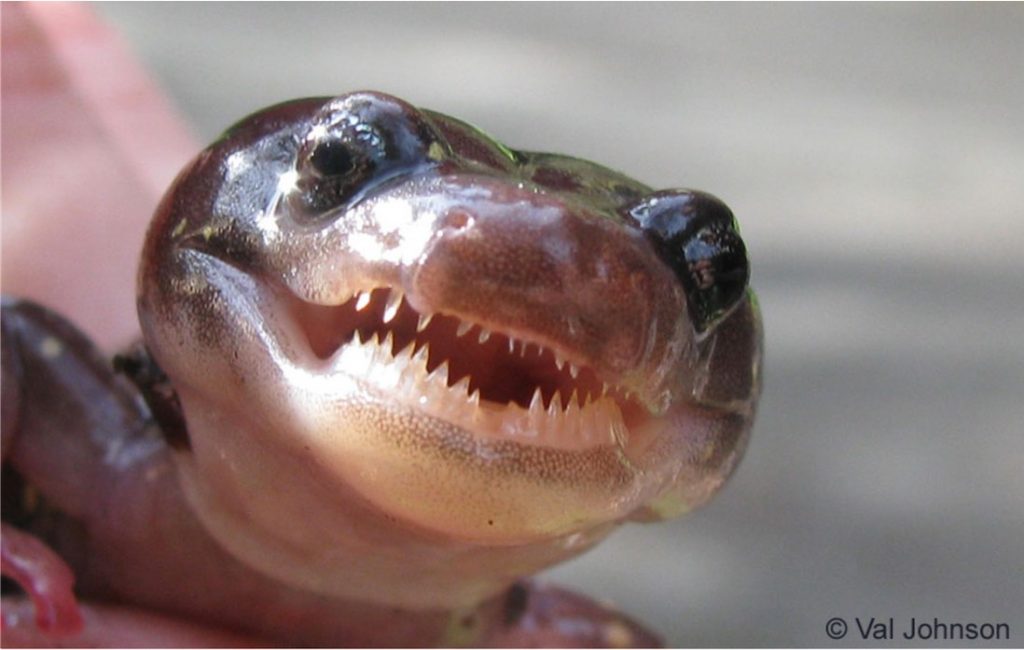
Arboreal Salamander from the Elkhorn National Estuarine Research Reserve CA
Salamanders are indeed diverse, and have had plenty of time to evolve into several species with varied but specific habitats. Of the approximately 740+ living species of salamanders worldwide, one-third of these species are found in North America, although only 7 of the 100 species of newts have been identified in North America. The classifications of salamander orders, suborders and families can be found in Wikipedia’s List of Amphibians of North America updated in March 2020. More species are being identified both by discovering previously unknown species and by new genetic analyses.
The southern Appalachian Mountains are considered a “biodiversity hotspot” for salamanders with the highest diversity of any region on Earth…by far! There are an estimated 65 salamander species in NC alone and 50 of them are in Western North Carolina. For example, 30 species of salamanders have been identified just in the Great Smoky Mountains National Park (re: their 2017 website), and it is estimated that there are approximately 3 salamanders in every 3 square meters in the undeveloped areas of Western North Carolina. These range in size from a 2-inch- long pygmy salamander to the 3-foot-long hellbender. Check out the herpsofnc.org website for a 2020 list of 46 of the estimated 65 species of salamanders in North Carolina with photographs.
Below is an example of a salamander discovered in 2009 in Georgia. It is the second-smallest salamander species in the United States and one of the smallest in the world. It is so distinct that it has its own genus categorization.
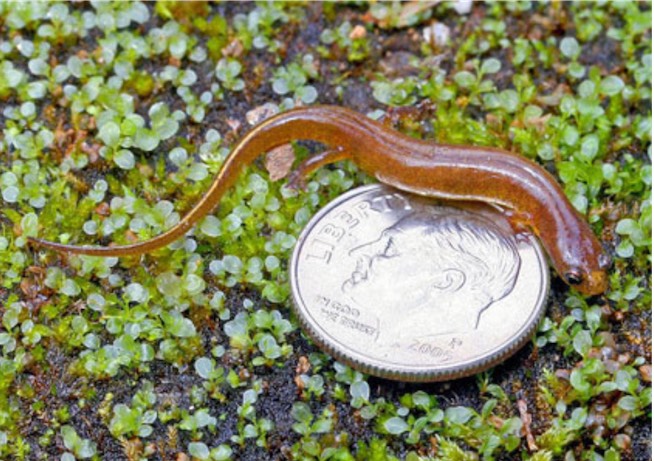
And here is a photograph of the largest species of salamander, the Chinese giant salamander. It can reach 6+ feet in length and live as long as humans. Unlike many salamanders that might be poisonous to eat, the Chinese giant salamander has become a highly desirable culinary delicacy among China’s super rich population and is now categorized as critically endangered and in catastrophic decline.
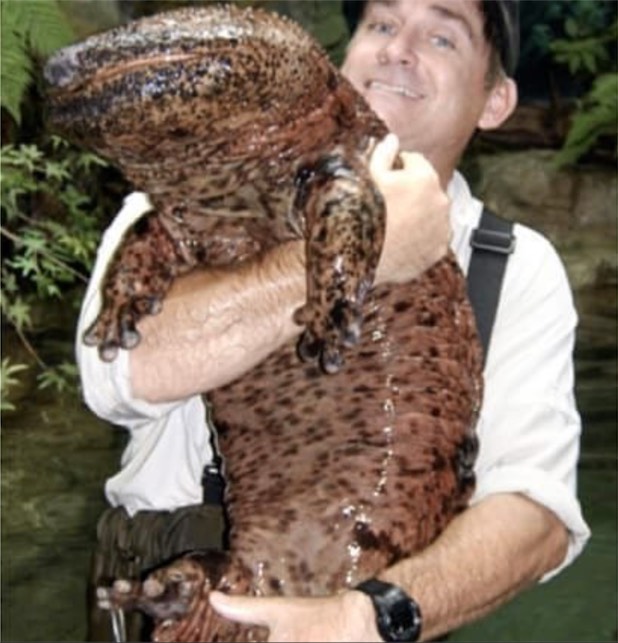
Most salamanders are nocturnal and can be found living in moist places, for example, in marshy areas and under rocks and fallen trees. Many salamanders at some period of their life live in both water and on earth, so they use gills, lungs, skin, and other organs for absorbing oxygen at various times during their development. Water is rich in oxygen and therefore diffuses readily through the skin surface of water dwelling creatures. Amphibian lungs are far less complex than mammal lungs and have been described as “essentially empty balloons.” We mammals breathe through expansion and compression of our lungs with assists from our ribs and the diaphragm. Amphibians instead use “buccal pumping” of the muscles in their throats to pull air through the nostrils into the mouth and into the lungs. It is an environmental puzzle why amphibians left their water environment millions of years ago. But they did, and now that they are on land, many amphibians breathe through rather simple lungs as well as through their skin, while some breathe primarily through their skin.
The Plethodontidae, the largest family of salamanders with nearly 400 species, are lungless. They breathe through their skin and the mucous membranes in their mouth and throat. These surfaces have to remain moist constantly to absorb oxygen. This breathing process seems restrictive, but since the family of lungless salamanders constitutes more than two-thirds of all salamander species including plethodids, it must work for them! (amphibiaweb.org February 25, 2019) All 55 species of the genus plethodon in the family Plethondontidae are found in North America. The southeast U.S. has more plethodids than anywhere else in the world, and some researchers believe that they are indigenous to North Carolina.
Recent genetic research has identified the molecular changes that makes breathing without lungs so efficient for salamanders and not for other vertebrates. A study by Lewis et al. (2018) found that lungless salamanders express a novel pair of genes of the gene surfactant-associated protein C (SFTPC) within the specific areas (such as the skin) that lungless salamanders use to breathe. In other vertebrates, the protein SFTPC is critical for gas exchange in the lungs and is expressed only in the lungs.
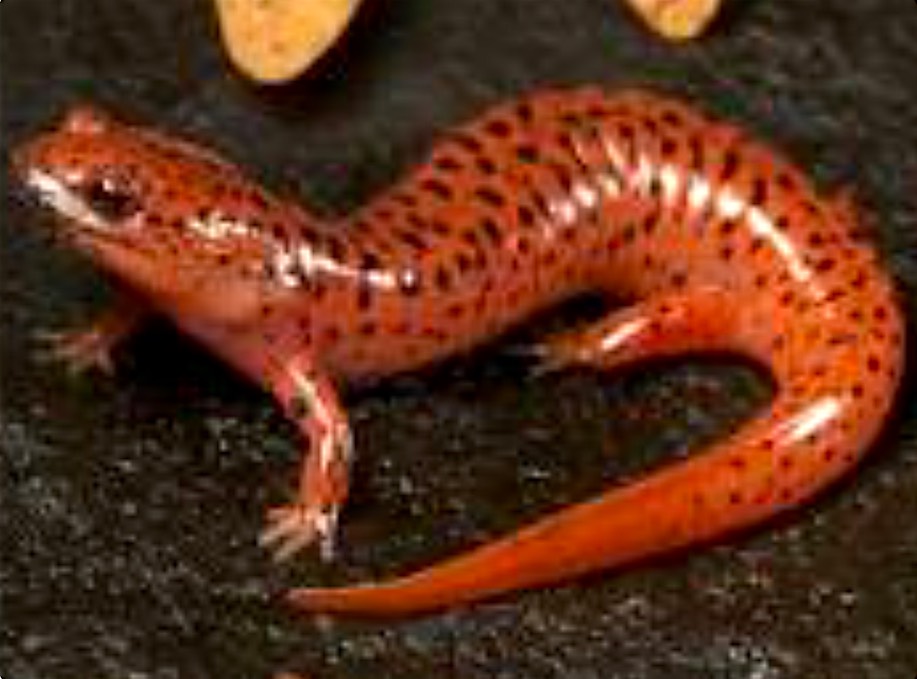
The lungless red salamander (Pseudotriton ruber) is found throughout the Piedmont and Blue Ridge Mountains of North Carolina usually around aquatic habitats such as headwater streams, seepages, and some wetland areas.
herpsofnc.org
The Plethodontidae are also known as woodland salamanders because they are entirely terrestrial and their bodies are kept moist by their damp, shaded forest habitats. Unlike frogs, toads and other salamanders, they have no aquatic larval stage, i.e., no waterborne infancy as legless larvae. Instead, woodland salamanders are born on land as tiny versions of their grown-up selves.
Another distinction of Plethodontid salamanders is that they are more agile than other salamanders and are known to jump, especially to escape predators. They jump by bending their bodies and then straightening out quickly with a snap. The height they can jump is scaled with body size and the length of their front legs, but they generally jump a maximum of 1.8 times head plus body length. Tail length doesn’t seem to affect jumping performance. Their agility extends to their tongues, too. They have long tongues, almost as long as their bodies, and they are adept at “tongue-slinging,” i.e., they don’t have to be face-to-face with their prey to capture them.
Here is an example of how a Plethodontid lungless/woodland species, the 2-3 inch red-backed salamander, manages the development of their eggs. After mating, the female red-backed salamander lays a cluster of up to 24 shell-less eggs and then spends most of the next two months with her body curled around her eggs to keep them moist and safe from predators. Over that roughly two month period, the young salamanders go through their entire larval development inside the eggs. After they emerge, the small salamanders stay near the female for several weeks until they are full sized.
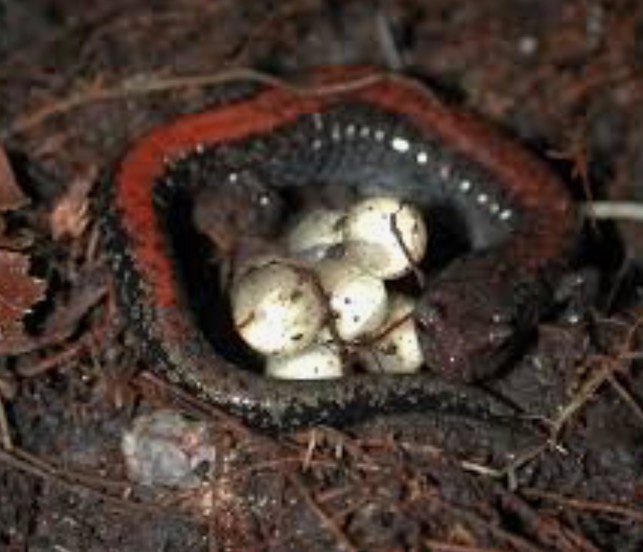
Photo: Metro Atlanta Amphibian Monitoring Program maamp.org
Salamanders generally reproduce by internal fertilization without any form of sexual intercourse. All amphibians, reptiles, birds, and a few mammals have a cloaca, a multi-purpose orifice from which they excrete both urine and feces and use for reproduction. Salamander fertilization is a tidy process: the male salamander seeks out the female, and then fans his tail to waft glandular secretions toward her. If the female salamander approaches him, the male deposits a “sperm packet”, a protein capsule containing a mass of sperm, in the water or on the ground next to the female and the female takes it into her body through her cloaca and deposits it into an internal pouch in her body. Usually eggs form and are then fertilized as they pass back out again through the cloaca. The eggs are shell-less but protected by a toxic, gel-like membrane. The process varies, however. In some species of salamanders the fertilized eggs are expelled from the female and hatch externally and in other species, the eggs remain within the female anywhere from three weeks to two years, even going through metamorphosis within the female. Many salamander species do have an aquatic larval stage during which they lay eggs that hatch in water and the newly hatched salamanders move to land. Sometimes the eggs are simply deposited in a burrow in the bank or on a leaf above a stream and the hatching larvae fall into the water below and then crawl out to land. Sometimes the eggs or larvae are transported to the water by one or another of the parents. Sometimes the larvae metamorphose in a terrestrial nesting site without ever moving to open water. And some salamander species, usually in harsh environments, simply skip the larval stage and reproduce full-sized salamanders with an adult body form.
Another interesting lungless salamander is the small four-toed salamander — it is so completely one-of-a-kind that it has its own genus (Hemidactylium scutatum). It is the only terrestrial salamander with four toes on all four feet; all other terrestrial salamanders have five toes on their hind feet. Four-toed salamanders are relatively easy to identify in other ways, too. Their bellies are bright white with black speckles. Also, they can detach their tails at will because they have a unique constriction on their tail, a “pinch-me-here” mark. Other salamanders can survive having their tails torn off by a predator but can’t release them voluntarily like the four-toed salamander. All lost salamander tails grow back in a couple of weeks. Note: salamander toes don’t have claws.
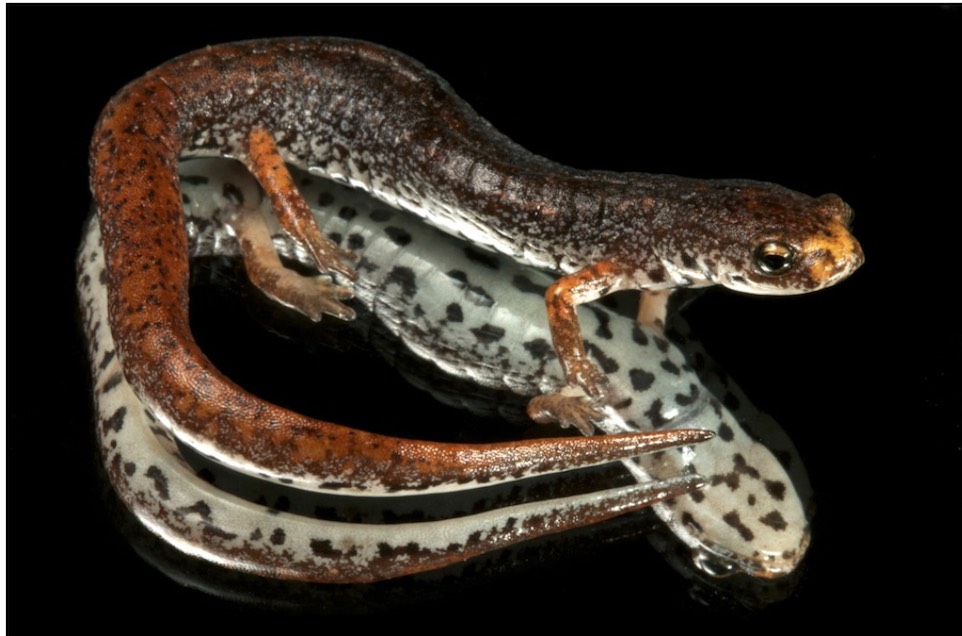
Photo credit: Todd Pierson
One of the most common and easily spotted salamanders in our area is the eastern red-spotted newt (Notophthalmus viridescent). They are native to eastern North America and found in small lakes, ponds, and streams or in moist areas of forests. They have an unusual life cycle that makes them easy to find in their juvenile stage. Like many salamander species, their eggs are laid in the springtime in water from which they hatch as larvae. After feeding all summer in the water, the gilled aquatic larvae metamorphose into lunged, terrestrial and brightly colored juvenile red efts with black spots.
During this in-between juvenile stage of their lives, red efts are easy to spot, bright red and fearlessly strutting along a trail like a cocky teenager. And they are strong and active and may feel fearless because in their juvenile state, they have lungs; a thicker skin that doesn’t need to be kept constantly moist; and they produce tetrodotoxin, a powerful neurotoxin, and their striking bright red-orange color is a warning to potential predators that they are toxic
Red efts, juvenile eastern red-spotted newts, remain in this in-between stage of their lives for 5-7 years, and during this time they are completely terrestrial. They do get around and can travel remarkably far during this colorful time of their lives. We saw one marching down our gravel road a few days ago, and he was moving! When it is time for them to mature into adults, red efts become simply newts again; their skin becomes thin once more and has to remain moist and so… back they go to living in the water.
As aquatic adults, their bright red/orange color fades to olive green on their backs and yellow on their bellies. They keep orange dots circled with black on their backs, however, which makes them easy to identify. Aquatic adult life may be more quiet for them than their roving juvenile period, but like most newts they have a more complex and possibly more exciting adult courtship. For example, they may grab each other and flip upside down together, flashing their yellow bellies for a while before the the male deposits a spermatophore and the female picks it up and places it into her body. Eastern red-spotted newts live total of 12 to 15 years in all three stages and usually grow to be 3 to 5 inches long.

Juvenile Red eft/Eastern Newt
“tough guy”
Photo from The Orianne Society
The juvenile red eft is a bright color, but most salamanders are a much more subdued and dull color…at least that’s how they look to us. Recently, however, it has been discovered that most amphibians, including salamanders, glow with bright fluorescent colors when exposed to UV light, especially blue light. Even their blotches, stripes, snotty secretions, urine, their bones and toes…and their larvae…glow with vivid colors after exposure to blue light, and their multipurpose cloacal organ shines as bright as a flashlight. Their rather eerie glow is produced by bio-fluorescence; their bodies absorb the shorter (higher energy) wavelengths of blue light and then re-emit that light at longer (lower energy) wavelengths of glowing colors. This ability to glow also appears to be fairly common among other species of amphibians — even if we can’t see it.
Do they see themselves in bright fluorescent colors? Apparently they do. Researchers hypothesize that bio-fluorescence may help amphibians find each other in dim light, attract mates, or help camouflage themselves from predators.
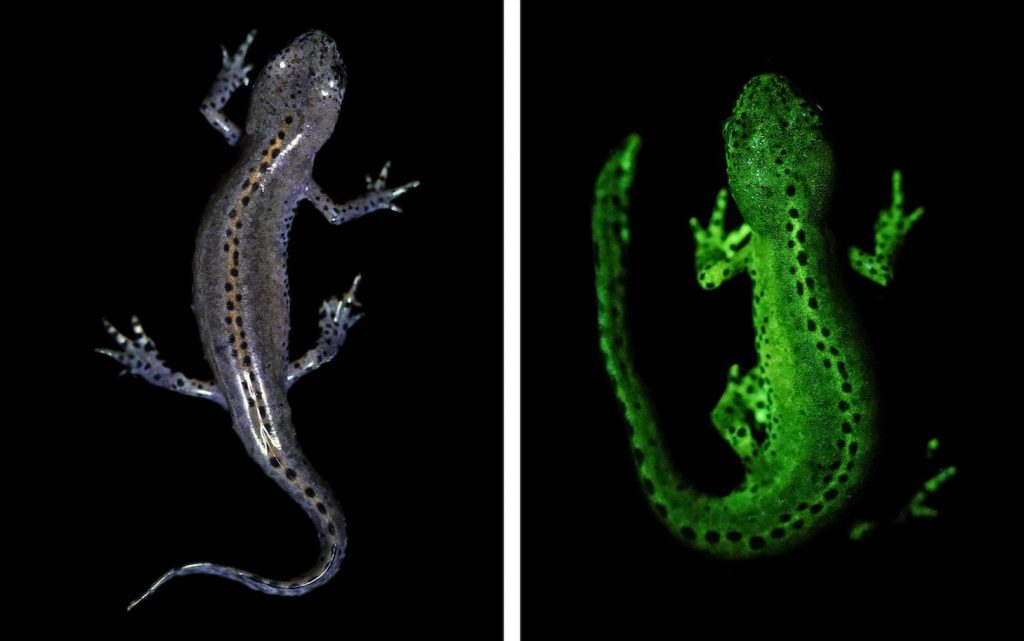
The NY Times February 27, 2020
Photo credit: Jennifer Lamb and Matt Davis
Salamanders and the mountains have been extant for 330+ million years. The mountains probably will survive climate change in one way or another, but will salamanders? Hopefully, yes! An experimental study (Riddell et al. 2018) found that Plethodontid salamanders show remarkably plastic responses to varying ecological conditions, which may bode well for their reactions to anticipated increases in climatic temperatures.
More than 40 percent of salamander species in the United States are listed as threatened, however, with habitat loss as the main reason for their decline. Other concerns include: invasive species like wild pigs; a fungal parasite that is reducing salamander populations in Europe; and declines in insect abundance that are of increasing concern for many reasons. Salamanders survived the Pleistocene extinctions, however, so hopefully they can shelter in place with other species to survive for many more millions of years. Meanwhile, I’m going to buy a blue-light flashlight and go out during our long summer evenings to search for salamanders and watch them glow.
Other references:
amphbia.web
Erickson-Davis, Morgan. Habitat loss, pigs, disease: U. S. salamanders face a tough situation. Mongabay Series: Salamanders. January 3, 2019.
Frick-Ruppert, Jennifer. Mountain Nature. The University of North Carolina Press. 2010.
Simpson, Ann and Rob. Nature Guide to the Blue Ridge Parkway. Morris Book Pubishing. 2013.
Klein, JoAnna. Salamanders and frogs hide a glowing secret. The New York Times, February 27, 2020.
Kunin, William E. Robust evidence of declines in insect abundance and biodiversity. Nature. 30 October 2019.
Zachary R. Lewis†, Jorge A. Dorantes‡ and James Hanken. Expression of a novel surfactant protein gene is associated with sites of extrapulmonary respiration in a lungless salamander. Department of Organismic and Evolutionary Biology and Museum of Comparative Zoology, Harvard University, Cambridge, MA 02138, USA July 2018.
Works by David B. Wake, Professor Emeritus, UC Berkeley Department of Integrative Biology. Internet archive.





60 comments